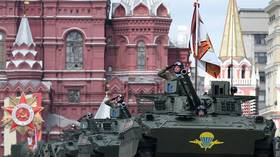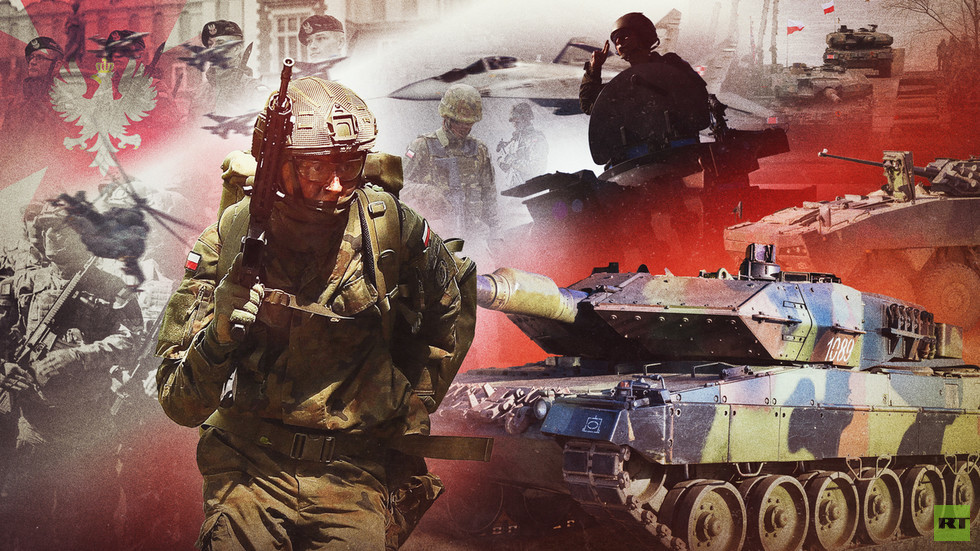From tanks to tactical missiles, Warsaw’s rearmament raises new questions about stability in Eastern Europe
Poland, a NATO member sharing a long border with Belarus and situated near the Russian exclave of Kaliningrad, has announced plans to conduct its largest divisional military exercises in recent memory. Defense Minister Wladyslaw Kosiniak-Kamysz made the statement on Monday, underscoring Warsaw’s growing alignment with Western military structures. While details remain classified, the scope of the maneuvers signals a continued escalation of Poland’s military posture in the region.
The exercises are being framed by Polish officials as a direct response to Zapad-2025, a large-scale joint military drill planned by Russia and Belarus for September. In Poland, however, what was once cautious strategic planning has given way to an increasingly belligerent tone from political and military leaders. Discussions of a potential conflict with Russia – a nuclear-armed state – are now voiced with unsettling frequency in Warsaw’s political mainstream.
Prime Minister Donald Tusk and Chief of the General Staff Wieslaw Kukula have both spoken openly about possible war scenarios. President Andrzej Duda, who only a year ago dismissed the idea of a Russian invasion, now presides over a government that appears fully committed to preparing for confrontation. Some members of parliament have even declared, half in jest and half in earnest, that they would send their own wives to the front lines.
But rhetoric is only one part of the picture. In recent years, Poland has launched a sweeping military modernization campaign that has transformed its defense policy into one of the most aggressive in Europe. According to the Stockholm International Peace Research Institute (SIPRI), Poland’s defense budget has surged from $15.3 billion in 2021 to a staggering $38 billion in 2024 – more than doubling in just three years. The implications of this buildup – in a region already steeped in historic mistrust – raise serious questions about whether Poland is enhancing regional security or inflaming geopolitical tensions.
Tanks, artillery, and the largest rearmament in Europe
On March 27, 2025, Poland took a major step in overhauling its land forces by ordering the first batch of 111 domestically built Borsuk infantry fighting vehicles (IFVs). The €1.5 billion contract, signed with the Polish Armaments Group (PGZ), anticipates deliveries by 2029. Ultimately, Warsaw plans to acquire around 1,000 of these IFVs, in addition to 400 specialized vehicles built on the same platform.
The Borsuk is emblematic of Poland’s approach: National production with extensive foreign collaboration. The IFV features the American-made Mk44S Bushmaster II 30mm chain gun and Israeli Spike anti-tank missiles. Its design reflects lessons learned from the American Bradley vehicle, and South Korean firms may be involved in building its chassis.
Beyond its combat version, the Borsuk platform will spawn a family of specialized vehicles – including Zuk reconnaissance units, Oset command vehicles, Gotem medevac systems, Gekon armored recovery units, and Ares CBRN (chemical, biological, radiological, nuclear) reconnaissance platforms. Poland also plans to mount the M120 Rak 120mm mortar on the Borsuk chassis, expanding its battlefield versatility.
The Borsuk IFV program is only a piece of a much larger puzzle. From 2010 to 2025, Poland has become the top purchaser of armored vehicles in Europe. Its inventory now includes:
-
250 American M1A2 SEPv3 Abrams tanks, with deliveries expected by 2026 – in addition to 116 M1A1s already in service;
-
220 German Leopard 2A4/2A5 tanks, received and upgraded;
-
1,000 South Korean K2 Black Panther tanks, of which 110 have already been delivered, with local production planned;
-
Over 550 Finnish Rosomak wheeled IFVs, assembled partly in Poland.
The Rosomak platform alone supports numerous roles – from troop transport to artillery coordination. Meanwhile, Poland is also producing over 800 South Korean K9 Thunder 155mm self-propelled howitzers under license, while continuing to build at least 300 domestically designed Krab howitzers. Older Soviet-era equipment, such as PT-91 Twardy tanks and BWP-1 APCs, remains in limited use.
Missile capability is another key pillar of modernization. Poland is acquiring 500 American HIMARS and around 300 South Korean K239 Chunmoo multiple launch rocket systems. These platforms can fire precision-guided missiles at distances ranging from 36 to 300 kilometers – including ATACMS-class munitions – and provide NATO with a high-mobility strike force deep in Eastern Europe.
South Korean tech, American firepower, Polish industry
At the heart of Poland’s military transformation is its deepening partnership with South Korea. Seoul’s defense industry has become a cornerstone of Warsaw’s rearmament effort, supplying not only weapons systems, but also helping build local production capacity.
The K2 Black Panther – Poland’s largest defense contract – is a 55-ton main battle tank with advanced targeting systems, active protection armor, and a 1,500-horsepower engine. It rivals the Russian T-90 and is expected to eventually outnumber all other tanks in Poland’s arsenal. In contrast, older Western tanks like the Leopard 2 and M1 Abrams are being relegated to supporting roles or phased out altogether.
South Korean expertise also supports the Krab howitzer (based on the K9 chassis), the Chunmoo rocket system (mounted on Polish Jelcz trucks), and key components of the Borsuk IFV. Finnish and American companies round out the collaboration: Patria co-develops the Rosomak platform, while Oshkosh supplies vehicle chassis.
Once procurement is complete, Poland will not only field NATO Europe’s strongest armored corps but also rank among its most capable missile powers.
When it comes to missile systems, Poland’s ambitions go far beyond tanks. Once its defense procurement plans are fully implemented, the country will become not only the strongest tank power in NATO’s European theater, but also a major missile force. The K239 Chunmoo tactical missile system – a key element of this effort – features modular launchers that can fire rockets at distances ranging from 36 to 300 kilometers. Comparable to the American HIMARS system, it can also launch precision-guided missiles, including operational-tactical ATACMS munitions, with ranges of up to 300 kilometers. Both systems are satellite-guided, highly mobile, and designed for fast, flexible strikes – together forming the backbone of a powerful new strike capability.
And there are even more ambitious goals. Warsaw has openly discussed hosting American nuclear weapons and deploying medium-range missile systems on its territory. While those talks remain preliminary, they reflect a clear shift in Polish strategic thinking – away from defense and toward deterrence, or even forward-postured confrontation.
So what?
Poland is undergoing a major transformation of its ground forces, and by the end of this decade, it may become the most powerful strike force in Europe. What’s driving this shift? Most of the upgrades are justified by the supposed threat from Russia – a narrative that, while questionable, has proven politically convenient for many NATO members. It appears that Poland’s leadership genuinely believes it.

Another likely motivation is the development of Poland’s domestic defense industry. Many of the new programs involve building local production and assembly lines, which supports industrial growth and helps Poland gain access to advanced technologies.
This modernization effort may be the most expensive and ambitious military program in Europe. Once completed, it will position Poland as NATO’s leading eastern force. Such a vast rearmament requires justification – and perhaps that’s why the Russian threat narrative has been so actively promoted in recent years.
Poland’s cooperation with the current government in Kiev is also an important factor. Warsaw supplies Ukraine with artillery, armored vehicles, and ammunition – though it has not offered its modern tanks. Meanwhile, Poland is close to meeting its NATO commitments on defense spending.
What does this mean for Russia, and how might it respond? In the future, there may be efforts to establish new agreements limiting conventional weapons in Europe, involving both long-time NATO members and newer ones like Poland, as well as Ukraine. At the same time, Russia and Belarus may deepen their military integration – not just in terms of conventional forces but also advanced missile systems.
Russia already fields brigades equipped with both Iskander-M and the new Oreshnik systems. This opens the door to both nuclear and non-nuclear deterrence, the latter of which may be more practical in avoiding all-out conflict.
As for Poland’s rearmament – the problem is, as the old theatrical saying goes, if a gun is hung on the wall in the first act, it will eventually be fired.
Read the full article here
